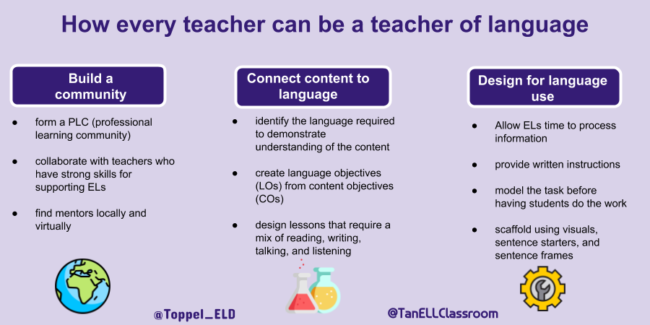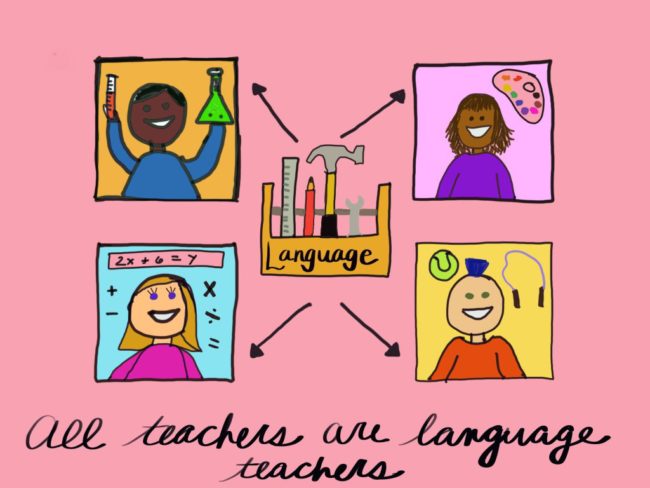This guest post was written by none other than the legendary, Dr. Katie Toppel who co-founded #ellchat_bkclub.
In her keynote presentation for the #VirtuEL18 Conference, Dr. Jana Echevarria very powerfully stated, “Our English learners are students who can least afford wasted instructional time” (Echevarria, 2018). In other words, instructional time that is not explicitly tied to developing skills in reading, writing, speaking, and listening can be considered a lost opportunity for English learners (ELs) to further advance their proficiency in English.
ELs not only learn of the English language, but they also learn content through English, so their exposure to targeted language instruction throughout the entire school day is paramount. For this reason, all teachers serve an important role in supporting students who are learning English.
Let’s take a look at a few compelling ways every teacher can support language development for English learners.
Build Community and Collaborate
It is common for teachers to identify solely as content teachers because that is their area of expertise (TESOL, 2018) and many content teachers do not feel prepared to support ELs in meeting the Common Core State Standards in their particular content areas (Education Week, 2014).
TESOL (2018) indicates that successful schools for English learners have a shared sense of community and responsibility for ELs, which stresses the necessity of collaboration between content teachers and language teachers in order to meet students’ linguistic needs in all aspects of their schooling.
When teachers come together with the shared goal of helping all students achieve at a high level, English learners will benefit. Also, investing time in ongoing professional development, in partnership with colleagues, is fundamental for better serving English learners. Collaboration, co-teaching, and participation in professional learning communities (PLCs) are all effective ways for teachers to share and increase knowledge around best practices for English learners.
Where to start:
- Create Community: Connect with colleagues outside of your specialty area and learn a little about what they teach. Ask questions, observe, and/or take a look at the standards in their discipline area. Try to see the bigger picture of what students experience as they go through their school day and look for ways you can support colleagues by sharing what you know and your strengths. Don’t hesitate to ask for help in areas where you may need support. Form Professional Learning Communities (PLCs) or take some time in existing PLCs to talk about language development and language instruction.
- Collaborate: If you are a teacher who does not feel confident supporting English learners, utilize your colleagues who have specialized training and knowledge around language development and acquisition. Ask for suggestions around what language forms and functions support your content. Language specialists can share information and strategies. They may even be able to model a lesson or team teach with you in order to support your learning.
- Find Mentors: Social media sites such as Facebook and Twitter also offer multiple avenues to pursue convenient and free professional development through groups and chats specifically geared toward improving instruction for ELs. These groups and chats are led by experts in the field of language development and involve educators who are both passionate about ELs and more than happy to support other teachers. Advocating for ELLs and Leading ELLs are two helpful groups on Facebook. Additionally, Twitter offers many chats where teachers can share information and ask questions. A few popular chats are: #EllChat, #EllChat_BkClub, #BoostingAchievement, and #CoTeachat.
Connect Content and Language
When language is taught as decontextualized skills, students may achieve proficiency on those particular skills, yet they may not understand or be able to use those skills in the context of connected language. They also may not understand how to leverage their language skills for content learning and demonstrating what they have learned in content classes. If language instruction is embedded within all content areas, the target language is essential and consequently, used, and practiced.
Where to start:
- Use Language Objectives: The direct correlation between the content being learned (content objectives) and the language required to demonstrate an understanding of that content (language objectives) not only provides ELs access to the core curriculum, but it also supports them in acquiring more language and provides them more opportunities to practice English. Language practice that aligns with content instruction provides students with a context and a purpose for their language use.
- SWIRL: SWIRL is an acronym that stands for speaking, writing, interacting, reading, and listening. The idea behind SWIRLing is to incorporate a connective thread between the language domains and to make sure students utilize all language domains during content area lessons. This will help students improve their skills in those language domains, while also helping them obtain new knowledge and proficiency around the target content.
Design for Language Use, and Provide Appropriate Supports
Too often, English learners remain quiet for the majority of their school day due to a myriad of factors such as confusion around expectations, anxiety/nervousness about speaking in front of peers, or lack of confidence in their language abilities. In many cases, expectations for language production, particularly speaking and writing, are lowered simply because of students’ status as language learners.
Teachers worry that requiring and expecting English learners to produce language in class will heighten their stress and further impede their success, therefore ELs are permitted to remain quiet with the expectation that they will participate when they are ready. It is important to clarify that simply having ELs in content or mainstream classrooms does not ensure that they will develop the academic language needed to engage in rigorous academic tasks.
Where to start:
- Provide Time to Talk: Talking about content is a vital strategy to process new learning. ELs need to practice speaking, but they also need additional time to think and process. Additionally, make sure that the grouping configurations allow them to feel comfortable to share their ideas. Partner practice, small groups, and recording functions on technology can all be used to help ELs feel safety and comfort so they are willing to talk in class. Teachers should also make it a habit to build in wait time before asking English learners to respond to ensure they have had time to think and prepare before sharing. English learners also benefit from opportunities to use their native language to process what they are learning.
- Provide Clear Expectations/Directions: Provide both verbal and written directions so students can hear and see what they are expected to do. Use visuals to support instruction and directions to help make concepts and expectations comprehensible.
- Model: Before asking students to produce verbal or written language, provide a model of what it should look and sound like. This can include modeling expectations for talking with a partner such as making eye contact, leaning in, and using academic language or showing students a sample of a writing piece.
- Scaffold: Use sentence starters or sentence frames to support students in their language production. Make sure keywords and sentence starters/frames are posted so students can use them as they speak or write.
The success of English learners is dependent upon many factors. Of utmost significance is that all teachers embrace the importance of supporting language development in conjunction with content instruction so that English learners have meaningful and continuous language instruction and practice. Helping ELs succeed is the responsibility of all teachers. All teachers are language teachers because no matter what we are teaching, we rely on language as the medium help students develop content knowledge.
Dr. Katie Toppel is a K-5 English Language Development Specialist in Oregon. She is also an Adjunct Professor at Portland State University in the area of ESOL. Dr. Toppel’s instructional background includes experience teaching Kindergarten and First Grade in addition to being a K-12 Support Services Teacher at the Franconian International School in Germany. She is also the co-founder of #EllChat_BkClub on Twitter, which is a virtual book club aimed at improving instructional practices for English Learners.
Echevarria, J. [Jana Echevarria]. (2018, May 13). How much should we “push” English learners? [Video File]. Retrieved from: https://www.youtube.com/watch?v=R49oVkd4MJg&feature=youtu.be
Education Week. (2014). From Adoption to Practice: Teacher Perspectives on the Common Core. [PDF file]. Bethesda, MD: Education Week Research Center. Retrieved from: https://www.edweek.org/media/ewrc_teacherscommoncore_2014.pdf
TESOL. (2018). The 6 principles for exemplary teaching of English learners. Alexandria, VA: TESOL International Association.



